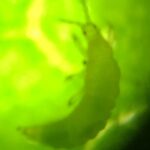by Rocketboy9
Greeting my fellow cultivators, I hope everyone’s day was close to perfect. Today I’m going to preach about all the beautiful things I love about worm castings sometimes called vermicast, worm poop or worm manure, it’s all the same thing. I want to start by mentioning that castings are the only fertilizer I know of that has very little order and is safe to use around kids and pets as well as indoors. The easy rule that I use for spotting quality castings is “the darker the better”, I like them to be a little darker than wet coffee grounds. Since castings are water activated, it’s ok if you get a bag of castings and it dries out a bit.
NOTE: When 10% – 20% of worm castings were mixed with composted dairy, horse, chicken manure, or plant compost almost all bad odors were eliminated within eight hours.
Worm castings aren’t really compost in the sense that a “hot” method isn’t used when it’s made compared to manure/plant compost. Castings are made inside worms which like a temperature range of 60-80 degrees F, while compost needs temps of 130 -170 degrees F.
Nutrients
You cannot overfeed or burn your plants NPK with worm castings because it won’t let the plant absorb more nutrients then it needs. Instead because of the beneficial microbes that are in it, the unused nutrients will be locked away in the soil until they’re needed. It’s also known that worm castings are a great source of NPK but the levels are about 1% for each and that seems low when compared to chemical fertilizers. But what we have to remember when we’re talking about nutrients is that availability is what’s important. You can have more than enough nutrients in your feeding mixture but if the plant can’t absorb them then they’ll just get washed away during watering/feeding. All of primary and secondary nutrients found in castings are in a form that can be fully absorbed by the plant because of all the beneficial micro-organism that live in castings. The same or higher rates of growth and a more balanced growth is seen in gardens where castings are used without having high concentrations of chemical fertilizer in the soils or waterways. As a matter of fact castings are pathogen free and have a huge role in cleaning up the soil that they’re put in.
Pest control
This is my favorite part of worm castings because aside from being a rich in nutrients it also has a surprise for pests. It helps the plant produce chitinase (kite-an-ase) in its sap. Chitin helps make up the exoskeletons of most bugs that can infest your cannabis plant. Chitinase breaks down chitin, so when a pest nibbles on the plant it gets a spicy dose of chitinase and it decides to move on.
Disease and Fungi
Some fungus is an essential part of healthy soil, but too much will cause problems when it gets out of control. Fungus eating protozoa and nematodes are in worm castings and using it in the soil mix will help control most fungus. It will also improve plant growth when extra nitrogen is released as the soil fungus is brought under control and within a few weeks, plants that had a fungus problem will show noticeable improvement. Because of the humus in the worm castings it has the ability to fight plant diseases by taking the toxins and bacteria from the soil and allowing them to be washed away as organic waste.
Soil benefits
Worm castings help make aggregates or mineral clusters in the soil or coco coir that help against water erosion and compaction, think of aggregates for water simply as clumps of sponges. It will also help balance the pH levels in the soil and adjust the carbon-nitrogen ratio so plants can take up nutrients easier.
When you feed a plant dry soil amendments like worm castings it will take about a week them to start to be broken down and absorbed by the plant and noticeable benefits could take as long as 10 day to two weeks. For faster absorption, worm castings can be made into a compost tea. Here is my simple “worm tea” recipe that I feed my plants at least once a month.
Worm Tea
Things you’ll need.
- 5Gal bucket of water
- 5Tbls of fish and kelp liquid fertilizer
- 1/3 cup molasses (the sugar feeds the microbes), sometimes the you’ll find a fish/kelp fertilizer with molasses already in it.
- 1 ½Tbls of “Recharge” (beneficial microbe soil amendment)
- 2Lbs (6 ½ cups) of worm castings wrapped up tight in cheese cloth or old t-shirt, like a tea bag.
- Air stone and pump (optional)
Now let’s put it together.
- Add the fish/kelp fertilizer and Recharge to the 5gallons of water.
- Drop in the tea bag of worm castings.
- Hook up the air stone to the air pump and put the stone in the bucket of water, then turn it on. It’s normal for the tea to start to foam up, it’s a good sign. The tea should be ready in about 24hrs.
If you don’t have an air stone and pump, don’t worry you can still make this tea. You’re going to do steps 1 & 2, but you’re going let everything sit in the bucket for 2 days. Remember to stir the bucket often.
Well we’ve reached the end of what I know about worm castings, I hope this helped. I’ll talk to y’all next time and as always “GROW, LEARN, TEACH”.







I believe and correct me if I’m wrong, you should be able to drop the molasses, out of the recipe, since recharge has some in it.
I’ve been brewing ewc tea for a couple of years and am just now starting to experiment with recharge, to see if it can simplify my recipe.
Stay stoned
You could drop the molasses, I just keep it in as extra food for the microbes.
I assumed that is what you were doing. Thanks for the response. Also, awesome write up on ewc.
Stay stoned
Thanks brother I appreciate the feedback. Checkout my blog at inmygrow.wordpress.com, let me know what you think.
I’m going to try this, but I have one question? When everything is in the 5gal with air stone and a pump wil there be any kind of smell to it?
Nice post!
I would actually leave the Recharge out of your brew and apply it separately. The microbes in Recharge are very robust and effective and they will likely out-compete any other beneficial microbes in the brew. Compost and worm castings bring their own unique microbes to the brew, but they are likely not as vigorous as the microbes in Recharge and would probably be unable to compete with Recharge microbes over the course of a 24 hour brew.
Recharge microbes were bred and isolated in a lab environment and were selected for use in Recharge due to their vigor as well as their effectiveness, so they are tough little bastards. Scotty has also said that the microbes in Recharge are intended to be applied to the root zone very soon after mixing with water, and its unknown how well they can survive for long periods in a liquid environment.
I have no hard data to back this up, but I suspect if you brew Recharge or even just let it sit too long in water, you will actually REDUCE the diversity of the microbes in the tea. Some species will be more suited to the brewing process than others, and those that enjoy a good brew will likely take over, while those that arent suited to the brewing process will start to die out.
I would also be careful adding things like fish or other fertilizers as its unclear how they react with microbes in a liquid solution over a long period of time, and too much would almost certainly reduce microbe populations.
Its hard to know whats going on for sure in compost tea without a fancy microscope and the skills to recognize what you are looking at, and I have neither so maybe I’m totally wrong. (I think my science is sound though)
Also, its worth noting that tea brewed with an air source will likely come out very different and contain different microbe species from tea brewed without one.
Actively Aerated Compost Teas (AACTs) aka brewed with an airstone, are different and have different benefits/drawbacks when compared to anaerobic teas brewed without an oxygen source. Both are great to use in your garden but they are basically different products with different, although similar benefits.
Great article. Thanks for the write up.
Awesome read… thanks for the info!!